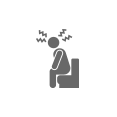‘The best way out is always through.’
Anxiety disorders are characterized by feelings of worry, anxiety, unease, or fear that are strong enough to interfere with your daily activities. Symptoms include stress that logically seems out of proportion to your emotional reaction, an inability to set aside a worry, and feeling restless.
There are a number of different disorders associated with anxiety. Here is a list of the anxiety disorders that we offer counselling for.
Generalized Anxiety Disorder: a psychological disorder characterized by excessive or disproportionate anxiety about several aspects of life, such as work, social relationships, or financial matters.
Social Anxiety Disorder: an anxiety disorder in which a person has an excessive and unreasonable fear of social situations. Also described as intense nervousness, anxiety and self-consciousness arise from a fear of being closely watched, judged, and criticized by others.
Obsessive-Compulsive Disorder (OCD): OCD involves unwanted and disturbing thoughts, images, or urges (obsessions) that intrude into a person’s mind and cause a great deal of anxiety or discomfort, which the person then tries to reduce by engaging in repetitive behaviors or mental acts (compulsions).
Post-Traumatic Stress Disorder (PTSD): PTSD is an anxiety disorder that can develop after experiencing or witnessing a traumatic event, or learning that a traumatic event has happened to a loved one. DSM5 defines a traumatic event as exposure to actual or threatened death, serious injury, or sexual violence.
Phobias: Phobias can be divided into specific phobias, social phobia, and agoraphobia. Types of specific phobias include certain animals, natural environment situations, blood or injury, and specific situations. The most common are fear of spiders, fear of snakes, and fear of heights.
Some of the symptoms associated with anxiety disorders include:
- Fatigue
- Restlessness
- Sweating
- Hypervigilance
- Irritability
- Racing Thoughts
- Worry
- Fear
- Insomnia
- Nausea/Constipation/Diarrhea
- Poor Concentration
- Increased Heart Rate
- Trembling
‘EVERY DAY BEGINS WITH AN ACT OF COURAGE AND HOPE: GETTING OUT OF BED.’
Depression is a common and serious medical illness that negatively affects how you feel, the way you think, and how you act. It is also treatable. Depression causes feelings of sadness and/or a loss of interest in activities once enjoyed and the feeling sad or having a depressed mood. Depression can lead to a variety of emotional and physical problems and can affect how a person functions in everyday life. Symptoms of depression can range from very mild to severe. For a person to be diagnosed with depression they must last for at least two weeks.
Depression affects an estimated 1 in 15 adults in any given year and 1 in 6 will experience some form of depression at some point in their life. It can occur at any time and happen to anyone, but on average appears during the late teens to mid-20s. Studies show women are more likely than men to experience depression and that one-third of women will experience a major depressive episode in their lifetime.
It is important to differentiate between depression and being sad. For example, the feelings after losing a loved one, the ending of a relationship, or the loss of a job are difficult experiences for someone to endure, but the response of the feelings of sadness or grief afterward is normal. Those who have experienced loss might describe themselves as depressed, but it is not the same as being diagnosed as depressed.
Depression is among the most treatable of mental disorders. Between 80 percent and 90 percent of people with depression eventually respond well to treatment. Almost all patients gain some relief from their symptoms.
If you have any of the below symptoms, you may have depression.
- Feeling sad or having a depressed mood
- Loss of interest or pleasure in activities once enjoyed
- Changes in appetite — weight loss or gain unrelated to dieting
- Trouble sleeping or sleeping too much
- Loss of energy or increased fatigue
- Increase in purposeless physical activity (e.g., hand-wringing or pacing) or slowed movements and speech (actions observable by others)
- Feeling worthless or guilty
- Difficulty thinking, concentrating, or making decisions
- Thoughts of death or suicide
Before a diagnosis or treatment, a health professional should conduct a thorough diagnostic evaluation, including an interview and possibly a physical examination. In some cases, a blood test might be done to make sure the depression is not due to a medical condition like a thyroid problem. The evaluation is to identify specific symptoms, medical and family history, cultural factors, and environmental factors to arrive at a diagnosis and plan a course of action.
‘You wake up every morning to fight the same demons that left you so tired the night before, and that my love is bravery.’
Post-traumatic system disorder or PTSD is a mental health condition that’s triggered by a terrifying event — either experiencing it or witnessing it. Symptoms may include flashbacks, nightmares, and severe anxiety, as well as uncontrollable thoughts about the event.
It is natural to feel afraid during and after a traumatic event or situation, as fear triggers the body and mind’s natural defense system to defend or avoid it. This “fight-or-flight” response is a typical reaction meant to protect us from harm. Nearly everyone will experience a range of reactions after trauma, yet most people recover from initial symptoms naturally. Those who continue to experience problems may be diagnosed with PTSD. People who have PTSD may feel stressed or frightened even when they are not in danger. It’s important to note that not everyone diagnosed with PTSD has experienced or been through a dangerous situation. Symptoms usually begin early, within three months of the traumatic incident, but sometimes they begin years afterward. Symptoms must last more than a month and be severe enough to interfere with relationships or work to be considered PTSD. The course of the illness varies. Some people recover within six months, while others have symptoms that last much longer. In some people, the condition becomes chronic.
To be diagnosed with PTSD, an adult must have all of the following:
- Re-experiencing symptoms/Intrusive symptoms, i.e. intrusive memories, nightmares and flashbacks.
- Avoidance of distressing trauma-related stimuli and triggers
- Changes in arousal and reactivity, i.e. feeling irritable, being hypervigilant, having sleep disturbances and self-destructive or reckless behavior.
- Negative changes to mood and thoughts, i.e. amnesia, distorted feelings of blame, decreased interest, and an inability to experience positive emotions.






